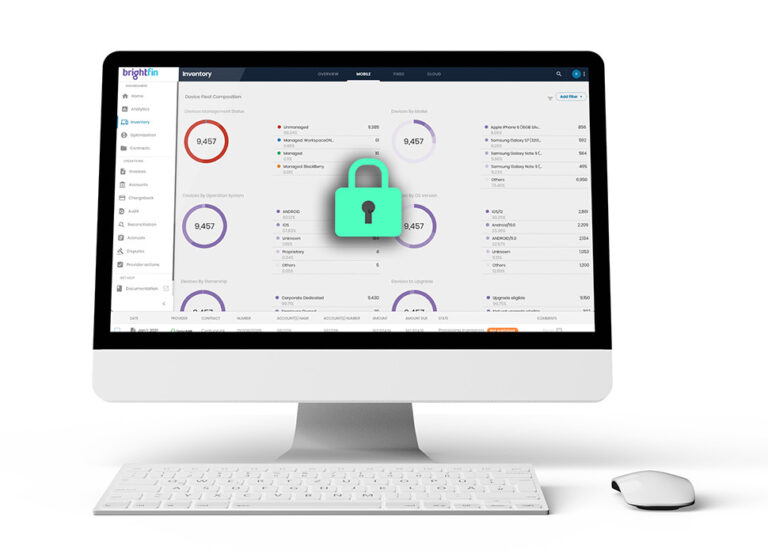Addressing old problems with new technology
Digital transformation is playing an increasingly important role in the construction sector. From measuring bid-to-win ratio, to software for safety and inspections, to how much a project is over budget or schedule, the more data you can use to back your work, the better. Data not only enables more visibility into particular projects, but relevant industry statistics and information can provide valuable information needed to make important future decisions regarding IT budgets, TEM services, and strategic initiatives.

With the need for automation and efficiencies increasing, how do construction firms keep up with technology changes and demands for 2021 and beyond?
Below, we’ll provide you with some important construction industry statistics, as well as actionable guides to manage IT assets, drive down costs, optimize TEM services, and gain transparency into IT expense management. With these tools, your company can be a leader in the future of construction.
After reviewing these industry trends and tips, you will:
- Learn how revolutionary technology and business transformation can increase industry-wide efficiency
- Understand the state of digital transformation in your organization
- Know how mobile and cloud technology can be correctly implemented

Download the full guide with actionable assessments and checklists to help optimize your IT budget
Outlining some of the driving challenges construction is facing
With challenges around project efficiencies, ongoing safety concerns and flatlining labor productivity levels, the construction industry is primed for digital transformation. Enabling new processes and using new resources that harness the power of data will help improve communication, efficiency, productivity, and safety. But, as with any digital transformation, new IT challenges are inevitable.
1. Stalling Productivity Levels
According to McKinsey & Co., “While many U.S. sectors including agriculture and manufacturing have increased productivity 10 to 15 times since the 1950s, the productivity of construction remains stuck at the same level as 80 years ago. Current measurements find that there has been a consistent decline in the industry’s productivity since the late 1960s.”

For construction executives, these findings are a cause for concern. Especially as building projects become more complex. Many factors contribute to the stall, such as inadequate planning and preparation, lack of collaboration between stakeholders on the project, time wasted waiting on materials and supplies, and waiting for prior work to be completed.
New construction methodologies such as design-build and lean construction practices, which require a high level of communication and collaboration among key players on a construction project, can improve efficiency and productivity. Technology such as building information modeling (BIM) and project management software are now critical tools that contracting firms can use to raise productivity.

2. Labor Shortages
During the economic downturn, the construction industry lost over 2 million jobs. Many of the critically skilled workers either retired or were laid off and moved to other industries. Now the construction industry is struggling to attract enough talent to meet growing demand. A survey by the AGC finds that 78% of firms are having trouble finding qualified workers. In addition, 82% of firms expect it to remain difficult, or get harder, to find and hire qualified workers looking ahead.

Additionally, workers in construction are aging out and retiring at a faster rate than the younger generation is coming in to replace them. Tech-savvy workers aren’t flocking to careers in construction as past generations have. All of this makes it complicated for construction firms to fill highly specialized roles.
3. Safety Challenges
Simply put, construction sites are dangerous places. Some of the dangers—like heavy construction equipment—are obvious. As such, worker safety continues to be an issue plaguing the construction industry. With the construction industry-leading in the total number of worker deaths and the number of workplace injuries and illnesses remaining constant, worker safety should be a top priority.
Training is the number one way to keep workers safe on the job site, and new technology can make ongoing safety training a reality. Ongoing training throughout a worker’s career can help avoid easily preventable risks. Safety starts at the top and companies that have strong safety programs have been shown to be more productive. A commitment to safety can improve a construction company’s reputation and attract top talent by showing an interest in the well-being of its employees.
Mobile and Cloud Technology in Construction
The days of simply loading your tools in the truck and showing up on a job site ready to trim some lumber and pound some nails are gone. Today’s construction professionals need to combine tools and tech to get ahead in the marketplace. This is where comprehensive TEM services can make all the difference.

Job site professionals can utilize smartphones and tablets to become more efficient than ever before. With these devices, contractors can capture and manage data more easily. Cloud technology and countless mobile apps help managers stay on schedule and within budget.
With mobile devices, you can easily store the necessary documentation, photos, project plans, and other pieces of information. This data is also easily accessed by multiple devices, which enables:
- Real-time authorization capabilities
- More efficient process flows
- Improved accuracy for inventory and materials
- Simpler scheduling and field reporting
- Reduced delays
- On-site signature capturing
- Easier customer payments
- No more lost paperwork
- Better crew transparency
- Improved safety compliance

According to the Occupational Safety and Health Administration (OSHA), nearly 6.5 million people work at approximately 252,000 construction sites across the nation on any given day. Safety is critical at every job site and many construction companies are turning to mobile devices to help boost safety by making it easier for construction managers to track training sessions, ensure compliance and report incidents or near-misses.

Before the cloud, the only viable way to really check on the status of a project was to go visit it in person, a task that takes hours out of the day. SaaS platforms can offer you a real time view into your jobsite from anywhere in the world. Customizable mobile apps make it easier for contractors to conduct safety inspection checklists, as well as identify health and environmental issues. The true value is all about communicating quickly and efficiently in order to get real-time responses. With mobile devices, supervisors can utilize GPS and other features to track employees on the job. They can also better track equipment and inventory.
With so many details to keep track of, construction managers are at an increased risk of human error. But with mobile devices replacing manual systems, and enabling instant communication, it’s easier to keep the entire business organized and reduce mistakes.

The construction industry can — and must — undergo as profound a digital transformation over the next few years as any business segment, spurred on by help from the cloud.
Marcus East
Article in Forbes
So how do you drive down IT budget year over year?
We’ve seen the impact of technology adoption in the construction space. With this level of digital transformation, technology spend continues to skyrocket. IT leaders are tasked with managing increasingly complex budgets, split across multiple teams and initiatives.
So how do you solve these technology challenges and drive down your budget?
Download the full guide to answer some questions and work through our device management checklist. In the guide, you’ll also find insights into how your peers are optimizing TEM services and IT budgets.



